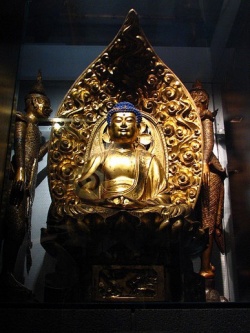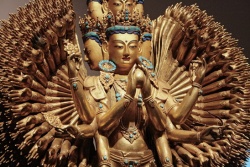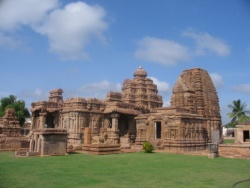Origins of the Prajnaparamita Literature
Herein, for the purpose of exegetic study, is presented the root treatise on Holy Transcendental Wisdom (arya prajna-paramita), consisting of XLI Stanzas extracted from the Ratna-gunasamucaya-gatha (Rgs) and representing the earliest known text on this subject.
There are some significant differences of attitude and philosophic outlook between this original text and later Prajnaparamita literature, which appears to point towards a gradual shift, over the centuries, in how Buddhist thinkers understood the nature of absolute Gnosis. Where, in our earliest known text, Transcendental Wisdom is viewed in a deliberately positive light and, though in no wise substantialized, is definitely recognized as an Absolute—an original Hagia Sophia prior to and at the back of created existence—in later texts such as the famous Heart Sutra, every positive affirmation of Her nature is abolished, in what appears as an excessively scholastic (as opposed to mystical) attempt to arrive at an utterly apophatic emptiness (sunyata). Historical parallels can be drawn here, following a general trend from early Buddhist mysticism to a later scholasticism, which in India is known to have occurred in all the major centres of learning, such as Nalanda, Vrikramasila, etc.
The Stanzas of the Practice of Holy Transcendental Wisdom consist of what later became the first two chapters of the Prajna-paramita-ratna-guna-samucaya-gatha. Prof. Conze and other Western scholars have suggested that these forty-one Stanzas of the Practice of Holy Transcendental Wisdom form the earliest known, original Prajnaparamita-sutra, which according to legend are said to have been written with blue vaidurya on golden plates, sealed with seven seals, and placed in the sikhara of a tower presumably in or near Gandhara, northwest India. As we review this text, its obvious precedence is startling. It may not, however, have originally been composed as a Sutra (i.e., an authentic scripture spoken by the historical Buddha); in fact, quite the contrary. The text itself begins by deliberately stating that it is a revelation, a treatise inspired by the Buddha's power, implying that no pretense is being made over the fact that it comes after Lord Sakyamuni's time, and is a work of a later Disciple. Just as the water of all the rivers of India flows from one common source, namely Lake Manasarovar in the Himalayas, likewise the true insight of a Disciple (sravakas) comes from the Buddha, says our text; it is precisely in that sense, and not in an historical sense, that the claim is put forth for this being a scripture of the Buddha!
We note that the traditional sutra-opening, i.e., Evam mayam sutram, is absent. In later productions of Prajna-paramita literature, this sutra-opening is artificially tacked on to the beginning of the text. What we appear to see here, is how an early text of great renown, circulated within the Buddhist community, became converted from the revelation of a Disciple into the word of the Buddha, as its popularity and the need for defending its doctrinal orthodoxy developed.
There appears to be a link between the text of the Prajna-paramita and early Christianity. In the Christian Book of Revelation (v,1) we read: "And I saw lying in the right hand of Him a book written within and without, closely sealed with seven seals." The legend of the origins of the text of the Prajna-paramita state that it was originally composed in the form of a book sealed with seven seals (sapta-mudra). The late Prof. Conze, in his analysis of this curious fact, has shown a series of parallels between Christian references to a secret book, seven seals, the role of Christ as a sorrowful, crucified messiah, and the Buddhist legend of the Bodhisattva Sadaprarudita, whose name indeed literally means "Ever-weeping," who traveled east in the company of a bar-girl like the reputed Saint Thomas "the Twin" (didymos) and who is reputed to have been associated with the "seven-sealed" text of our present study. Conze has pointed out a number of curious parallels between certain passages given in the Astasahasrika-prajnaparamita-sutra and the Christian Revelation attributed to St. John the Theologian, suggesting that the legend of the origins of the Book of Transcendental Wisdom "written on golden tablets with melted vaidurya, and sealed with seven seals" (asya kutagarasya madhye suverna-pattesu vilinena vaiduryene likhitva aryena Dharmaodgatena bodhisattvena mahasattvena saptabhir mudrabhir mudrayitva sthapita sa na sukarasmabhis tava darsayitum), which was shut up in the said tower (kutagara) by the Mahasattva-Bodhisattva Dharmodgata, is taken in part from a Christian reference to such a book. As Prof. Conze has stated, the parallelism between the Astasahasrika and Revelation is not confined to this one passage, but extends over the entire context.1
Much of the thought expressed in our text, and certainly in later Arya-Prajnaparamita texts, is derivative of the Madhyamaka philosophy of Saint Nagarjuna. In classical Tibetan studies up to this point, it has always been stated that Nagarjuna acquired his philosophical view from his readings of the Prajna-paramita Sutra. However, the trend of modern scholarship would show that the true case is the other way around. The philosophical vision expressed in the Prajnaparamita Sutra springs from the thought of Nagarjuna.
The Mulamadhyamaka-karika, composed by Saint Nagarjuna probably in the first century AD, shows no sign of literary dependence on any Vaipulya-sutra. It is now suggested by western scholars that Nagarjuna was wholly unaware of the Mahayana Movement that later blossomed largely in his name. Indeed, he was probably an Abbot in one of the traditional branch schools of the Mahasamghika Order flourishing in the south of India.
A later and distinct Nagarjuna is known, who without question must have been both a member of the Sarvastivada Order and an abbot-professor of Nalanda University. This latter figure, disciple of someone named Rahulabhadra, wrote a commentary on the Pancavrimsati-sahasrika-Prajnaparamita-sutra. He obviously may be associated with Mahayana developments, as with the literature of the Prajna-paramita in India. The Tibetans wrongly conflate the two Nagarjunas, not appreciating that Nalanda University was only founded and built several hundred years after the life time of the author of the Mula-madhyamaka-karika.
The date for the composition of the Stanzas on the Practice of Arya-Prajnaparamita is unknown. However it certainly may be placed at an early period. Is it even pre-Christian? We do not know. Conze would tend to incline towards this view. But how are we to understand its obvious usage of Sophia gnosticism. As we know, the figure of divine Wisdom (sophia) spans a literary history long associated with, though not confined to, Hellenistic Judaism and early Christian writings.2 She appears in the non-Christian Gnostic epistle of Eugnostos the Blessed as the feminine side of the immortal Proto-anthropos and as Mother of the Universe. In some early Christian writings she is identified with the Holy Spirit, which in consequence is viewed as the syzygos (female aspect and consort) of God the Father. Or she appears as the syzygos of Christ. In at least two places in the New Testament (1 Cor. 1-2 and Q) we can find mention of her. Paul speaks of "a Sophia of God hidden in a mystery" (1 Cor. 6-7). The epitaph "Mother of All-the-Tathagatas" applied to Bhagavati Prajna-paramita would seem to link her to the concept of the Theotokos, and related maternal imagery, as it was disseminated throughout the Middle East in the early centuries AD.
Further research is needed on this matter, but it does appear that the legendary career of Sadaprarudita has remarkable similarities to the Acts of St. Thomas, an apocryphal New Testament description of the overland journey of Jesus' so called twin brother (both the Gk. didymos and L. thomae mean twin) to Northwest India.
The most important feature of the Forty-one Stanzas is that it is from this original text, as stated by Prof. Conze, that all other versions of the Prajnaparamita-sutra have derived. From the Mahayana Buddhist perspective these Stanzas are therefore The One Key Text for an understanding of the original Prajnaparamita teachings. This understanding must take place within the context of Prajnaparamita literature as a whole. We would suggest, that for this purpose, it is first essential to appreciate the underlying meaning of the name, Transcendental Wisdom, particularly from its original intent, and secondly, the historical role played out in the evolution of these unique treatises in Buddhism.
First, the name: The primary term in usage here is Prajnaparamita. It is important to remember the different meanings in which the term Prajnaparamita is used. As explained by Dignaga3 (vide Prajna-paramita-artha-samgraha), the term means:
The nondual Gnosis of the Buddha (jnanam advayam sa Tathagatah), where nondual (adwaita) means "non-differentiated by subject and object" (grahya-grahaka);
The Path (marga) leading to the attainment of the Nondual, in the sense of the "spiritual knowledge" (prajna) which leads to realization; and
The Sutras (written texts) themselves, which reveal this knowledge.
The term Prajna is generally translated "wisdom". Frequently and unfortunately the term Paramita is translated "perfection", as for example in Geshe Kelsang Gyatso's rendition of Prajnaparamita, the "Perfection of Wisdom" (see Heart of Wisdom, Tharpa Publ., London 1986). Conze makes the same error. In English this implies that the said "wisdom" is something that can and needs to be perfected—a knowledge that is to be gained, developed and matured, until it becomes finally perfect. This is not the meaning of Prajnaparamita. When the early texts speak of Transcendental Wisdom, they imply an immutable, primordial Wisdom that is utterly absolute, transcendental and complete.
Let us look at the way in which the Tibetan translators converted the Sanskrit "paramita" into their language. To translate paramita they coined the term pha-rol-tu phyin-pa which is pronounced Pa-rol-tu chin-pa, and which means "that which is gone beyond" or which "pertains to the beyond", i.e., a Sophia that is transcendental, supra-mundane (lokuttara), that exists "beyond" this world. Pha-rol-tu is an adverb meaning "beyond" (or "abroad" in a colloquial sentence such as "he went abroad"). For example it can be said of someone that he has "gone on a journey" (lam-du phyi-yul-du phyin-pa). Phyin-pa (pronounced Chin-pa) means 'gone', or 'done'. So the Tibetan translators put together the phrase "gone beyond" to create an adverb meaning transcendental, the "beyond-state." This adverb is describing the nature of the Wisdom, shes-rab.
Thus Prajnaparamita should be translated not "Perfection of Wisdom" but rather "Transcendental Wisdom", with the explicit understanding that this Wisdom is the nondual Gnosis of the Absolute. The whole Universe of relative and differentiated existence (bhava) depends ultimately on Wisdom as its source, its womb, and as such, this primal Wisdom, the Mother of existence, is nondual and absolute. This is the basic meaning of Prajnaparamita herein.
Second, the historical evolution of the basic texts: We also use the term Prajnaparamita to mean the actual collection of treatises or Sutras which contain the teaching of the practice of Prajnaparamita. There are known to be a little more than 16 of these treatises. There are some texts in Chinese translation which do not appear in Tibet, but following the Tibetan tradition, we tend to classify the whole collection under two headings, namely, those referred to as Mother-texts and those considered Sibling-texts. There are six Mother-texts and at least ten Sibling-texts.
Western scholars are convinced, on good evidence, that there was an original Root Text (mula-sutra) and that gradually various expanded (vailpulya) redactions of the Root Text were fashioned. By examining internal evidence in the texts themselves, they have been able to suggest the progression in which these redactions appeared. In the East, however, the tradition is that all the texts are original and fixed Sutras since the inception of Buddhism itself. As said by Prof. Conze: "...religious people are inclined to attribute their holy scriptures to divine inspiration, and they do not like to think of them as an historical sequence of utterances made by fallible men."4 For our part we consider that these unique texts are indeed the result of divine inspiration, or intuition, but We do see them very much as part of an historical sequence of revelation. Thus, we are able to reconcile both the Eastern and the Western points of view. There are authentic historical references to a Root Treatise (mula-sutra) in the Astasahasrika-prajnaparamita-sutra. This root treatise was said to have been communicated by the Acarya Dharmodgata to his disciple Sadaprarudita, a seeker from the West. Sadaprarudita is described as a layman, in that he is a Bodhisattva with a female companion. Through making an exceptional self-sacrifice, he becomes worthy to be entrusted with the sacred text, much like Parceval in the later Grail Legends.
Here is a list of the ensuing treatises in their historical sequence of composition:
The Six Mother texts:
302 gathas - Ratnaguna-samucaya-gatha
8,000 slokas - Astasahasrika
10,000 slokas - Dasasahasrika
18,000 slokas - Astadasasahasrika
25,000 slokas - Pancavrimsatisahasrika
100,000 slokas - Satasahasrika
The Ten Sibling texts:
2,500 slokas - Suvikrantavikramipariprccha
700 slokas - Saptasatika
500 slokas - Pancasatika
300 slokas - Trisatika (= Vajracchedika)
150 slokas - Naya-sata-pancasatika
25 slokas - Prajnahrdaya (Heart Sutra)
1 syllable - Ekaksari
50 slokas - Ardhasatika Kausika-prajnaparamita-tantra Svalpaksara-prajnaparamita-tantra
The general consensus amongst scholars at the present time is that the initial 41 verses of the first Mother text, the Samucayagatha (Tib: sDud-pa [Kg. Ser.1 no. 11), constitutes the substance of the original Prajnaparamita-mulasutra; the root text from which all the 'expanded' (vaipulya) versions have sprung. However, as Conze explains,
"Unfortunately our present version of the Samcaya-gathal is not the original one. It has been tampered with in the eighth century when, under the Buddhist Pala dynasty, which then ruled Bihar, the great expert on Prajnaparamita, Haribhadra, either rearranged the verses or, perhaps, only divided them into chapters."5
Haribhadra nevertheless could not, we do not think, have done much damage to the initial 41 gathas, since their archaic metre and language still bears the signature of the Prakrit original. The Ratna gunasamcaya gatha is composed exclusively in the vasantatilaka metre, which is quite regular throughout. It appears to be the only existing Prajnaparamita text written in so-called Buddhist Sanskrit. Akira Yuyama has published a descriptive grammar of the Indic Recension A of this text.6 Again as shown by Conze, these verses form a single block of text, held together by the recurring line "and that is the practice (carya) of the absolute Transcendental Wisdom" (prajna-vara-paramitaya)." This is very significant.
Further, when the initial 41 Stanzas of the Samucayagatha are examined in the light of a study of the Heart Sutra, we find that the Heart Sutra is a close commentary, or restatement, on just this block of verses. It is, for example, in the Samucaya gatha that we find the earliest reference to the disciples receiving their inspiration "from the power of the Buddha" (vide verse 4). And it is here too that we read how "form, feeling, thought, motivation, and consciousness, are not united, never bound, and not in need of liberation" (verse 20). The line of the Heart Sutra, "...since there is no acquisition, Bodhisattvas abide in reliance on Transcendental Wisdom... Having utterly transcended erroneous views, they acquire ultimate Nirvana," nicely parallels verse 22, "Thus transcending the world, he eludes our apprehensions..." He goes to Nirvana, "but no one can say where he went to." Although Conze also supplies the information that many passages in the Heart Sutra parallel lines belonging to the Pancavimsati, a fact to be kept in mind. As Conze states:
"The Prajnaparamita texts are elusive to our understanding, because they are full of hidden hints, allusions, and indirect references to the pre-existing body of scriptures and traditions circulating in the memory of the Buddhist community at the time. They are more often than not an echo of older sayings. Without the relation to the older sayings they lose most of their point. We at present have to reconstruct laboriously what seemed a matter of course 1,500 years ago."7
A. K. Warder tells us that,
"Of all those now available the Eight Thousand [Astasahasrika-Prajnaparamita-sutra] is apparently the oldest. According to a tradition recorded in Tibet the Purva and Apara Saila [Mahasanghika] schools had a Perfection of Understanding (in Prakrit, those extant are more or less in Sanskrit, the older ones probably 'Sanskritised' and the later ones written in Sanskrit; the least Sanskritised is the only one in verse, the Ratnaguna-samucayagatha, which is closely related to the Eight Thousand and may preserve parts of the old Saila text, though with later additions)."8
The concept of an Absolute Wisdom, or supreme Omniscience (vidya), primordial and transcendent, existing prior to the creation of the Universe (and from which our consciousness (vijnana) of worldly experience has taken birth), apparently entered Buddhism fairly early, if indeed, in some ways, it cannot be traced back to Buddhism's inception. The historical Buddha himself asserted a very positive view of what we would define as an "ultimate absolute" or "permanent transcendental Reality" when he said: "There is an Unborn, Unoriginated, Uncreate and Unformed. If there were not this Unborn, this Unoriginated, this Uncreate, this Unformed, liberation from the world of all that is born, originated, created, and formed, would not be possible." Call it the Absolute, call it God, call it Buddha, or merely call it the supreme Intelligence (vidya), or as in our text, transcendental Wisdom (Sophia/Prajna), however it is called, the statement nevertheless is an emphatically positive assertion.
This is the main point where this specific text—the Practice of Arya Prajnaparamita—is very important in the history of Buddhist thought. More and more as dry scholasticism took the field in Buddhist studies, we have been told that all positive assertions (asti ="it is") should be negated. The apophatic trend alone was held to be true. Nagarjuna's own position was said to be prasanga, a pure critique asserting nothing. But is that not an utter misrepresentation of the great Saint's view? Here we have a text showing us a far more orthodox and authentic vision of early Mahayana Buddhism. It is therefore essential that this text be used, as opposed to later renditions of the Wisdom literature (such as the much overrated Heart Sutra), in an attempt to arrive at a more orthodox and authentic ground for our understanding of Transcendental Wisdom.
Footnotes
1 Conze, The Composition of the Astasahasrika Prajnaparamita, Bulletin of the London School of Oriental and African Studies, 14,1952, pp. 251-62.
2 See: B. Lang, Frau Weisheit (Dusseldorf 1975); Wilckens and Fohrer, Sophia, Theological Dictionary of the New Testament, Grand Rapids, 1971; Hengel, Judaism and Hellenism, Philadephia 1974; Kuchler, Fruhjudische Weisheitstraditionen, Gottingen 1979; etc., etc.
3 See Obermiller, Prajnaparamita in Tibetan Buddhism, Delhi 1988. p.6
4 Conze, The Perfection of Wisdom in Eight Thousand Lines, Bolinas CA. 1973
5 Conze, The Perfection of Wisdom in Eight Thousand Lines, Bolinas CA. 1975
6 See: Yuyama, Grammer of the Rgs (Sanskrit Recension A), Canberra 1973; "Some Glossarial Notes on the Rgs, " Proceedings and Papers of the XIV Congress of the Australasian Universities Language and Literature Association, Dunedin 19-28 Jan. 1972; "Remarks on the Metre of the Rgs," Studies in Indo-Asian Art and Culture, II (Raghu Vira Volume), New Delhi 1973
7 Conze, The Prajnaparamita-hrdaya Sutra, Journal of the Royal Asiatic Soc., 1948, pp. 33-51
8 A. K. Warder, Indian Buddhism, Delhi, 1970






